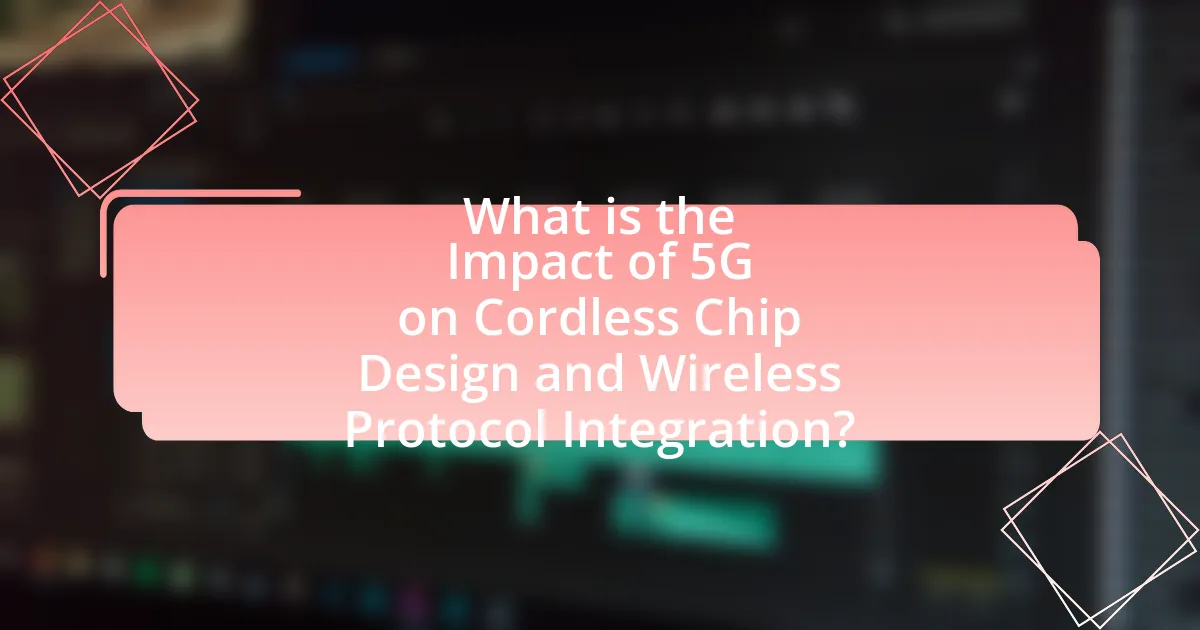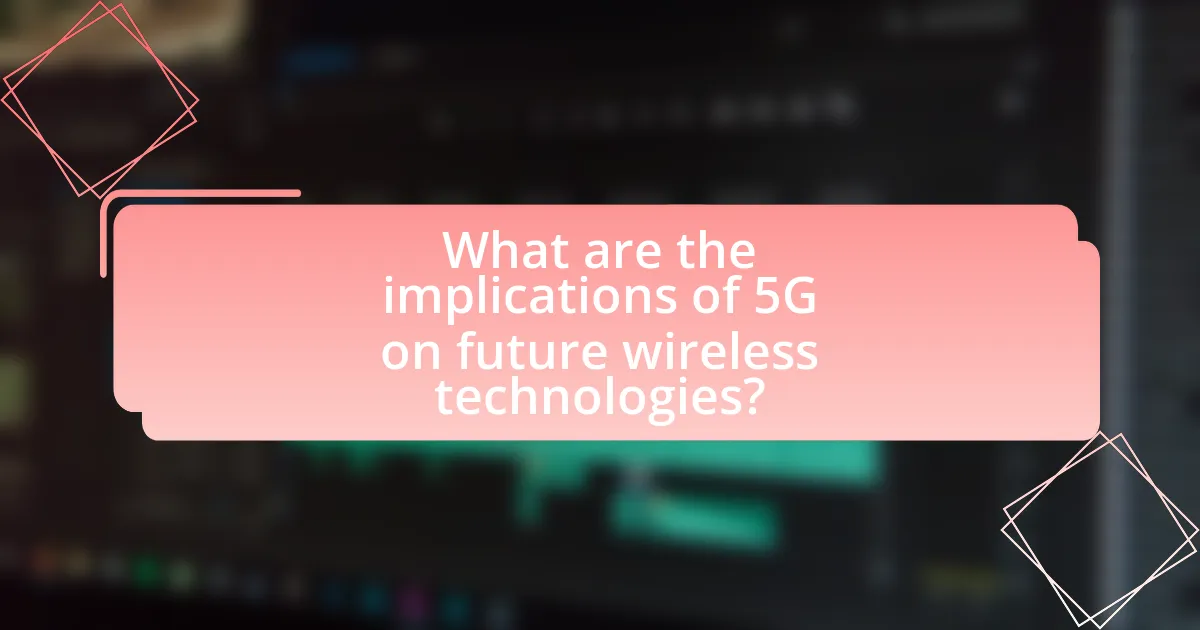The article examines the impact of 5G technology on cordless chip design and wireless protocol integration. It highlights how 5G’s enhanced data rates, reduced latency, and increased device connectivity necessitate innovations in chip architecture, including advanced modulation schemes and energy-efficient designs. The integration of new wireless protocols is essential to support diverse applications such as IoT and ultra-reliable low-latency communication. Additionally, the article discusses the challenges of integrating these protocols with existing systems and outlines best practices for ensuring compatibility with future wireless standards. Overall, the advancements driven by 5G are reshaping the landscape of wireless communication and chip design.

What is the Impact of 5G on Cordless Chip Design and Wireless Protocol Integration?
5G significantly influences cordless chip design and wireless protocol integration by enabling higher data rates, reduced latency, and increased device density. This advancement necessitates the development of new chip architectures that can handle the enhanced performance requirements of 5G networks, such as advanced modulation schemes and multi-antenna technologies. Additionally, the integration of wireless protocols must evolve to support the diverse applications and services enabled by 5G, including IoT connectivity and ultra-reliable low-latency communication. The shift towards 5G also drives the need for improved energy efficiency in chip design, as devices will require longer battery life while maintaining high performance.
How does 5G technology influence cordless chip design?
5G technology significantly influences cordless chip design by necessitating higher data rates, reduced latency, and improved energy efficiency. The introduction of 5G requires chips to support advanced modulation schemes and multiple-input multiple-output (MIMO) technology, which enhances data throughput and connectivity. For instance, 5G can achieve speeds up to 10 Gbps, compelling chip designers to innovate in processing capabilities and power management to handle increased bandwidth while maintaining low power consumption. Additionally, the integration of new wireless protocols, such as NR (New Radio), demands that cordless chips be designed with greater flexibility and adaptability to accommodate diverse applications and use cases, including IoT devices and smart home technologies.
What are the key features of 5G that affect chip design?
The key features of 5G that affect chip design include enhanced data rates, reduced latency, increased capacity, and support for massive device connectivity. Enhanced data rates, reaching up to 10 Gbps, necessitate advanced processing capabilities in chips to handle high-speed data transmission efficiently. Reduced latency, targeting as low as 1 millisecond, requires chips to optimize processing speed and responsiveness, impacting architecture and design choices. Increased capacity, allowing for more simultaneous connections, demands chips that can manage higher bandwidth and support advanced modulation techniques. Finally, support for massive device connectivity, with the potential for up to 1 million devices per square kilometer, influences chip design to incorporate efficient power management and scalability features. These factors collectively drive innovations in semiconductor technology to meet the demands of 5G networks.
How do increased data rates in 5G impact chip architecture?
Increased data rates in 5G significantly impact chip architecture by necessitating higher processing speeds and enhanced energy efficiency. To accommodate data rates that can exceed 10 Gbps, chip designs must incorporate advanced semiconductor technologies, such as FinFET transistors, which enable faster switching and lower power consumption. Additionally, the integration of multiple processing cores and specialized hardware accelerators, like digital signal processors (DSPs) and application-specific integrated circuits (ASICs), becomes essential to manage the increased computational demands of 5G applications. These architectural changes are supported by industry trends, such as the shift towards 7nm and 5nm fabrication processes, which allow for more transistors on a chip, thereby improving performance and efficiency.
What role does wireless protocol integration play in 5G?
Wireless protocol integration is crucial in 5G as it enables seamless communication between diverse network components and devices. This integration facilitates the efficient use of multiple frequency bands and supports advanced features like network slicing, which allows for tailored services to different user needs. The integration of protocols such as NR (New Radio) with existing technologies ensures backward compatibility and enhances overall network performance, allowing for higher data rates and lower latency. This is evidenced by the 5G specifications set by the 3rd Generation Partnership Project (3GPP), which detail the interoperability requirements necessary for effective wireless communication in 5G networks.
How does 5G change the requirements for wireless protocols?
5G significantly alters the requirements for wireless protocols by introducing higher data rates, lower latency, and increased device connectivity. These enhancements necessitate protocols that can efficiently manage massive data throughput, support ultra-reliable low-latency communication (URLLC), and accommodate a vast number of simultaneous connections, as evidenced by the International Telecommunication Union’s (ITU) specifications for 5G, which target peak data rates of up to 20 Gbps and latency as low as 1 millisecond. Consequently, existing protocols must evolve or new protocols must be developed to meet these stringent performance criteria, ensuring seamless integration and operation within the 5G ecosystem.
What are the challenges of integrating new protocols with existing systems?
Integrating new protocols with existing systems presents several challenges, primarily due to compatibility issues, resource constraints, and the complexity of legacy systems. Compatibility issues arise when new protocols do not align with the architecture or standards of existing systems, leading to potential communication failures. Resource constraints, including limited bandwidth and processing power, can hinder the effective implementation of new protocols, especially in environments where legacy systems are already operating at capacity. Additionally, the complexity of legacy systems often complicates the integration process, as these systems may require significant modifications or updates to accommodate new protocols, which can be time-consuming and costly. These challenges are particularly relevant in the context of 5G integration, where the need for seamless interoperability between new and existing wireless technologies is critical for optimizing performance and user experience.

What are the benefits of 5G for cordless chip design?
5G technology significantly enhances cordless chip design by providing higher data rates, reduced latency, and improved energy efficiency. These advancements enable cordless devices to transmit data more quickly and reliably, facilitating real-time applications such as augmented reality and IoT connectivity. The increased bandwidth of 5G allows for more devices to connect simultaneously without degradation in performance, which is crucial for densely populated environments. Additionally, 5G’s low latency, often below 1 millisecond, supports applications that require immediate feedback, such as remote control systems and autonomous devices. Furthermore, the energy efficiency of 5G networks can lead to longer battery life for cordless devices, as they can transmit data more effectively, reducing the need for frequent recharging.
How does 5G enhance performance in cordless devices?
5G enhances performance in cordless devices by providing significantly higher data transfer speeds, lower latency, and increased capacity for simultaneous connections. These improvements enable cordless devices to operate more efficiently, allowing for faster downloads, smoother streaming, and enhanced responsiveness in applications. For instance, 5G can achieve speeds up to 10 Gbps, which is substantially faster than previous generations, facilitating real-time data processing and communication in smart home devices and IoT applications. Additionally, the reduced latency of around 1 millisecond compared to 4G’s 30-50 milliseconds allows for instantaneous interactions, crucial for applications like remote control and augmented reality. The increased capacity supports a larger number of devices connected simultaneously without degradation in performance, which is essential as the number of wireless devices continues to grow.
What improvements in latency can be expected with 5G?
5G technology is expected to significantly reduce latency to as low as 1 millisecond, compared to 4G’s latency of around 30-50 milliseconds. This drastic improvement enables real-time communication and enhances applications such as autonomous vehicles, remote surgery, and augmented reality. The reduction in latency is achieved through advanced technologies like network slicing and edge computing, which optimize data transmission and processing.
How does 5G support more simultaneous connections?
5G supports more simultaneous connections through advanced technologies such as Massive MIMO (Multiple Input Multiple Output) and network slicing. Massive MIMO utilizes multiple antennas at the base station to serve multiple users simultaneously, significantly increasing capacity. For instance, a 5G base station can support up to 100 times more devices than 4G, allowing for thousands of connections in a single area. Network slicing enables the creation of virtual networks tailored to specific use cases, optimizing resource allocation and ensuring that different types of traffic can coexist efficiently. This combination of technologies allows 5G to handle a higher density of connections, making it suitable for environments with many connected devices, such as smart cities and IoT applications.
What innovations in chip design are driven by 5G?
5G drives innovations in chip design primarily through the development of advanced semiconductor technologies that enhance processing power, energy efficiency, and integration capabilities. These innovations include the adoption of smaller process nodes, such as 7nm and 5nm technologies, which allow for more transistors on a chip, leading to improved performance and reduced power consumption. Additionally, the integration of multiple functionalities, such as radio frequency (RF) components and digital processing units on a single chip, enables more compact designs and better performance in mobile devices. The need for low-latency communication and high data rates in 5G networks has also spurred the creation of specialized chips, such as application-specific integrated circuits (ASICs) and system-on-chip (SoC) solutions, which are optimized for specific tasks like signal processing and network management. These advancements are validated by industry reports indicating that the global 5G semiconductor market is projected to grow significantly, reflecting the increasing demand for innovative chip designs that support 5G technology.
What new materials and technologies are being utilized?
New materials and technologies being utilized in the context of 5G and cordless chip design include advanced semiconductor materials like gallium nitride (GaN) and silicon carbide (SiC), which enhance efficiency and performance in high-frequency applications. These materials enable higher power densities and improved thermal management, crucial for 5G infrastructure. Additionally, technologies such as Massive MIMO (Multiple Input Multiple Output) and beamforming are being integrated to optimize signal strength and coverage, facilitating better wireless communication. The adoption of these materials and technologies is supported by industry research indicating that GaN devices can operate at higher voltages and frequencies compared to traditional silicon, leading to significant improvements in 5G network performance.
How are power efficiency and thermal management evolving?
Power efficiency and thermal management are evolving through advancements in semiconductor materials and design techniques, particularly in the context of 5G technology. The transition to materials like gallium nitride (GaN) and silicon carbide (SiC) allows for higher efficiency and better thermal performance compared to traditional silicon. For instance, GaN devices can operate at higher voltages and frequencies, reducing energy loss and heat generation, which is critical for the dense integration required in 5G applications. Additionally, innovative cooling solutions, such as advanced heat sinks and liquid cooling systems, are being developed to manage the increased thermal output from high-performance chips. These developments are essential as 5G demands more power and generates more heat due to its higher data rates and increased device density.

What are the implications of 5G on future wireless technologies?
5G significantly enhances future wireless technologies by enabling higher data rates, lower latency, and increased connectivity for a vast number of devices. This advancement allows for the development of more sophisticated applications, such as the Internet of Things (IoT), smart cities, and autonomous vehicles, which require seamless communication and real-time data processing. The introduction of 5G technology is expected to drive innovations in cordless chip design, as manufacturers will need to create chips that can handle the increased bandwidth and support advanced wireless protocols. Additionally, 5G’s ability to support network slicing will facilitate the integration of diverse wireless protocols, allowing for tailored connectivity solutions that meet specific application requirements. These implications underscore the transformative potential of 5G in shaping the future landscape of wireless technologies.
How will 5G shape the development of future wireless protocols?
5G will significantly shape the development of future wireless protocols by introducing enhanced speed, lower latency, and increased capacity, which will enable more efficient data transmission and connectivity. The implementation of 5G technology allows for the integration of advanced features such as network slicing and massive machine-type communications, which are essential for supporting diverse applications ranging from IoT devices to autonomous vehicles. These advancements necessitate the evolution of wireless protocols to accommodate higher data rates and more simultaneous connections, as evidenced by the International Telecommunication Union’s (ITU) specifications for 5G, which outline requirements for peak data rates of up to 20 Gbps and latency as low as 1 millisecond. Consequently, future wireless protocols will need to be designed with these capabilities in mind, ensuring they can leverage the full potential of 5G networks.
What trends are emerging in wireless communication due to 5G?
Emerging trends in wireless communication due to 5G include enhanced data speeds, reduced latency, and increased connectivity for a vast number of devices. 5G technology enables download speeds exceeding 10 Gbps, which is significantly faster than 4G, allowing for real-time applications such as augmented reality and telemedicine. Additionally, 5G reduces latency to as low as 1 millisecond, facilitating instantaneous communication crucial for applications like autonomous vehicles. The technology also supports massive machine-type communications, connecting up to one million devices per square kilometer, which is essential for the Internet of Things (IoT) expansion. These advancements are reshaping wireless communication by enabling smarter cities, improved industrial automation, and advanced mobile broadband services.
How might 5G influence the standardization of wireless protocols?
5G is likely to accelerate the standardization of wireless protocols by establishing a unified framework that supports diverse applications and devices. This new generation of wireless technology introduces advanced features such as ultra-reliable low latency communication (URLLC) and massive machine-type communications (mMTC), which necessitate standardized protocols to ensure interoperability and efficiency across various sectors. The 3rd Generation Partnership Project (3GPP), which develops global telecommunications standards, has already begun to incorporate 5G specifications into its protocol frameworks, demonstrating a clear shift towards harmonization in wireless communication standards. This standardization is essential for enabling seamless connectivity and fostering innovation in industries reliant on 5G technology, such as IoT and smart cities.
What best practices should be considered in cordless chip design for 5G?
Best practices in cordless chip design for 5G include optimizing power efficiency, ensuring low latency, and enhancing signal integrity. Power efficiency is critical as 5G networks demand higher data rates and increased device connectivity, necessitating designs that minimize energy consumption while maintaining performance. Low latency is essential for applications like autonomous vehicles and real-time communications, requiring chips that can process data quickly and efficiently. Enhancing signal integrity involves using advanced materials and techniques to reduce interference and improve overall communication reliability. These practices are supported by industry standards and research indicating that efficient chip design directly impacts the performance and scalability of 5G networks.
How can designers ensure compatibility with future wireless standards?
Designers can ensure compatibility with future wireless standards by adopting a modular design approach that allows for easy upgrades and integration of new technologies. This strategy involves using flexible architectures and open standards, which facilitate the incorporation of emerging protocols without extensive redesign. For instance, the use of software-defined radio (SDR) technology enables devices to adapt to various wireless standards by simply updating the software, thus ensuring longevity and relevance in a rapidly evolving landscape. Additionally, staying informed about industry trends and participating in standardization bodies, such as the 3rd Generation Partnership Project (3GPP), helps designers anticipate changes and align their products with future requirements.
What strategies can be employed to optimize performance in 5G environments?
To optimize performance in 5G environments, strategies such as network slicing, advanced antenna technologies, and edge computing can be employed. Network slicing allows for the creation of multiple virtual networks on a single physical infrastructure, enabling tailored services for different applications, which enhances efficiency and resource utilization. Advanced antenna technologies, including Massive MIMO (Multiple Input Multiple Output), improve signal quality and capacity by utilizing multiple antennas at both the transmitter and receiver ends. Edge computing reduces latency by processing data closer to the source, thereby improving response times for applications requiring real-time data. These strategies collectively enhance the overall performance and user experience in 5G networks.

